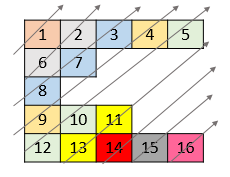英文原文
Given a list of lists of integers,
nums, return all elements of nums in diagonal order as shown in the below images.
Example 1:

Input: nums = [[1,2,3],[4,5,6],[7,8,9]] Output: [1,4,2,7,5,3,8,6,9]
Example 2:

Input: nums = [[1,2,3,4,5],[6,7],[8],[9,10,11],[12,13,14,15,16]] Output: [1,6,2,8,7,3,9,4,12,10,5,13,11,14,15,16]
Example 3:
Input: nums = [[1,2,3],[4],[5,6,7],[8],[9,10,11]] Output: [1,4,2,5,3,8,6,9,7,10,11]
Example 4:
Input: nums = [[1,2,3,4,5,6]] Output: [1,2,3,4,5,6]
Constraints:
1 <= nums.length <= 10^51 <= nums[i].length <= 10^51 <= nums[i][j] <= 10^9- There at most
10^5elements innums.
中文题目
给你一个列表 nums ,里面每一个元素都是一个整数列表。请你依照下面各图的规则,按顺序返回 nums 中对角线上的整数。
示例 1:

输入:nums = [[1,2,3],[4,5,6],[7,8,9]] 输出:[1,4,2,7,5,3,8,6,9]
示例 2:

输入:nums = [[1,2,3,4,5],[6,7],[8],[9,10,11],[12,13,14,15,16]] 输出:[1,6,2,8,7,3,9,4,12,10,5,13,11,14,15,16]
示例 3:
输入:nums = [[1,2,3],[4],[5,6,7],[8],[9,10,11]] 输出:[1,4,2,5,3,8,6,9,7,10,11]
示例 4:
输入:nums = [[1,2,3,4,5,6]] 输出:[1,2,3,4,5,6]
提示:
1 <= nums.length <= 10^51 <= nums[i].length <= 10^51 <= nums[i][j] <= 10^9nums中最多有10^5个数字。
通过代码
高赞题解
解题思路
根据矩形的特点,设行的标号为i,列的标号为j。则对于每一条对角线而言,i + j的值是唯一的。
(可以参考 LeetCode探索 中 “哈希表” 的部分)
知道这一点之后,就可以按照对角线对nums中的值进行聚类。聚类完毕后,将所有的数值生成一个数组即可。
代码
class Solution {
public int[] findDiagonalOrder(List<List<Integer>> nums) {
int len = 0;
Map<Integer,List<Integer>> map = new TreeMap<>();
for(int i = 0;i < nums.size();i++) {
len += nums.get(i).size(); // 获取最后要返回的数组的长度,即元素个数
for(int j = 0;j < nums.get(i).size();j++) {
if(map.containsKey(i + j)) {
map.get(i + j).add(nums.get(i).get(j));
}
else {
List<Integer> list = new ArrayList<>();
list.add(nums.get(i).get(j));
map.put(i + j, list);
}
}
}
int[] ans = new int[len];
int index = 0;
for(int key : map.keySet()) { // 遍历map
List<Integer> list = map.get(key);
for(int j = list.size() - 1;j >= 0;j--) { // 根据题目的输出要求确定生成数组中元素的顺序
ans[index] = list.get(j);
index++;
}
}
return ans;
}
}统计信息
| 通过次数 | 提交次数 | AC比率 |
|---|---|---|
| 7060 | 17577 | 40.2% |
提交历史
| 提交时间 | 提交结果 | 执行时间 | 内存消耗 | 语言 |
|---|




